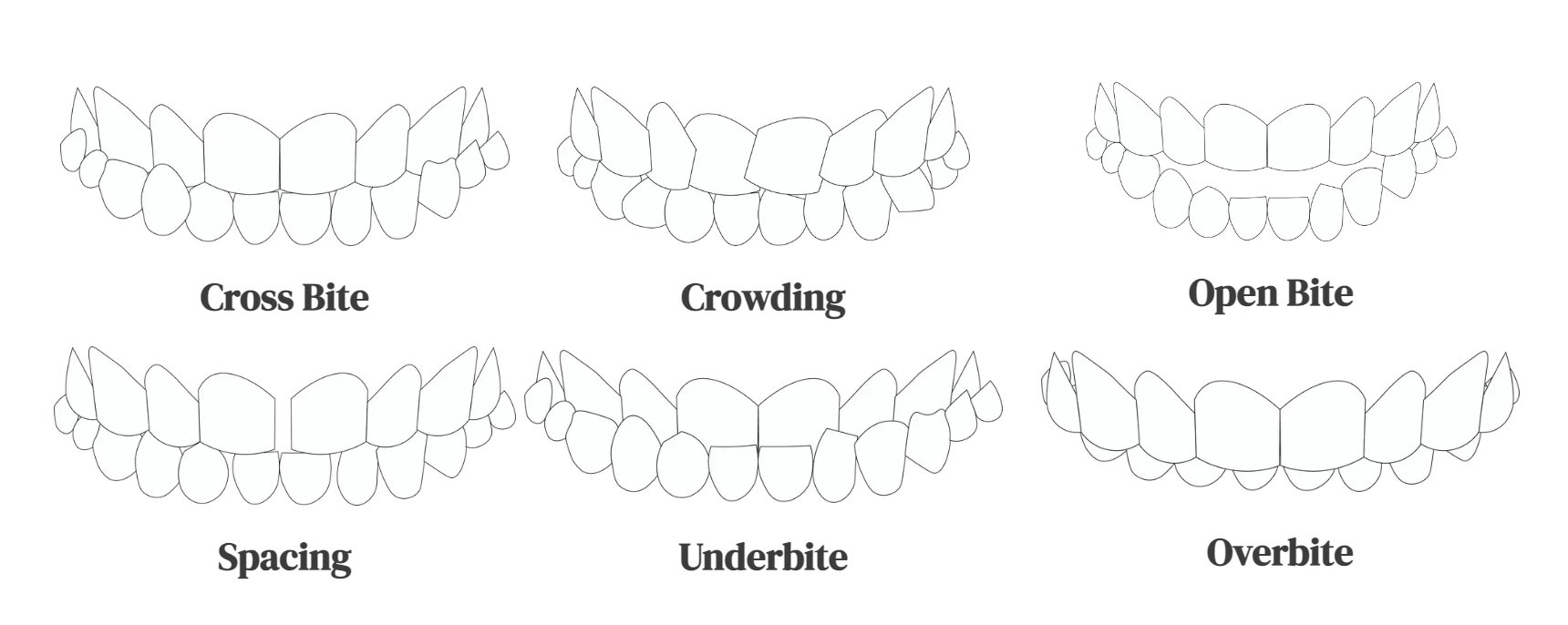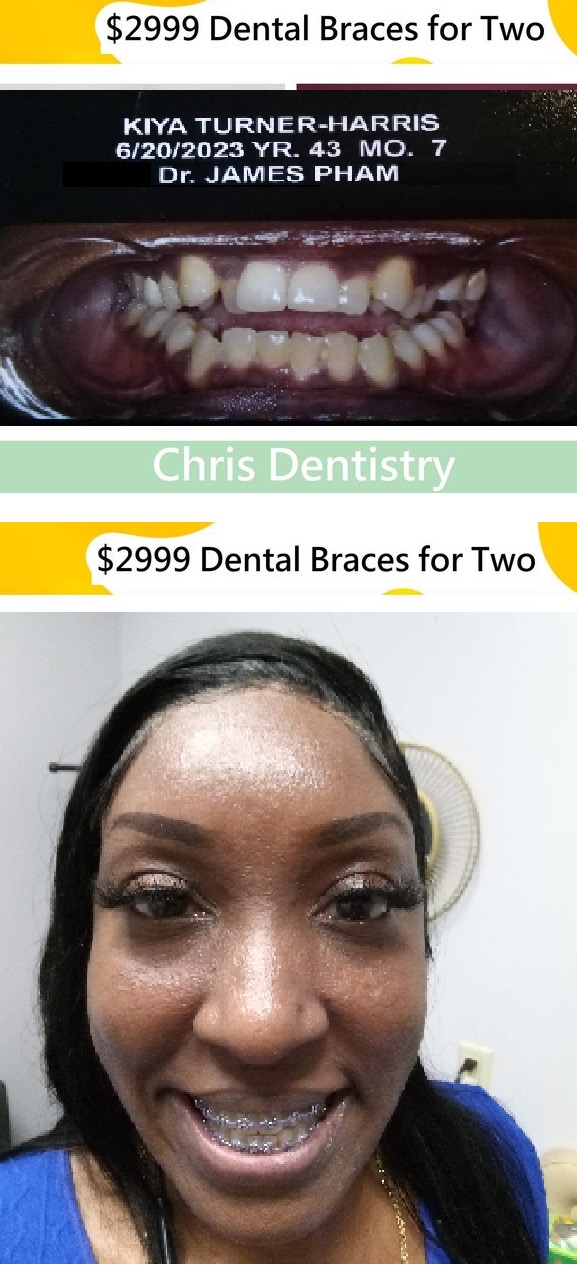
Affordable Dental Braces for Baytown Residents
If you are looking for an affordable orthodontics treatment near Baytown, call Chris Dentistry.

FREE, FREE, FREE this month
Our special Promotion. For the 1st 10 patients.
Buy one and get one FREE on orthodontic braces.
One free wisdom tooth surgery, and much more. Remember to tell your friends
and family members. "Share this Promotion"
— celebrating your special day.
|
Orthodontic braces are recommended for various reasons:
Overall, orthodontic braces offer a reliable and effective solution for correcting dental alignment issues, improving oral health, and enhancing the smile. |
|
Orthodontics works by applying gentle pressure to the teeth and jaws to gradually move them into their correct positions. This is achieved through the use of various orthodontic appliances, such as braces or clear aligners, which exert force on the teeth to guide them into alignment. Here's how orthodontic treatment typically works:
Alvin Orthodontic treatment requires careful planning, monitoring, and collaboration between the orthodontist and the patient to achieve optimal results. By gradually guiding the teeth into their correct positions, orthodontic treatment can improve the alignment of the teeth, enhance oral function, and create a healthier and more attractive smile. |

|
Malocclusions, or improper bites, can manifest in several different ways. Here are some common types of malocclusions:
Each type of malocclusion requires specific orthodontic treatment tailored to the individual's needs and goals. An Alvin orthodontist can assess the malocclusion and recommend the most appropriate treatment approach to achieve optimal dental alignment and oral health. |
You can send us the pictures for Free estimates. Email to Piiam@dr.com
|
The average cost of orthodontic treatment can vary widely depending on the factors I mentioned earlier. However, to give you a rough estimate, traditional metal braces typically range from $3,000 to $7,000. Clear aligner treatments like Invisalign tend to be slightly more expensive, often ranging from $3,000 to $8,000 or more, depending on the complexity of the case and the number of aligners needed. Keep in mind that these are just rough averages, and actual costs can vary based on your specific needs and location. It's best to consult with an orthodontist for an accurate assessment and cost estimate tailored to your situation. Many orthodontic offices also offer payment plans or financing options to help make treatment more manageable. |
 |
| Patient gave permission to post the treatment according to HIPPA. Google Review. |
Free Virtual Orthodontics Consultation
You can send your pictures to piiam@dr.com for free consultation
|
Understanding Biofilm: The Invisible Challenge to Oral Health. 6.22.2024 Biofilms are a pervasive yet often misunderstood aspect of oral health that can significantly impact dental hygiene and overall well-being. These complex communities of microorganisms adhere to surfaces in the mouth, including teeth, gums, and dental appliances, creating a protective shield that makes them resistant to traditional cleaning methods. Understanding biofilms is crucial for maintaining optimal oral health and preventing dental issues. What is Biofilm Biofilm is a structured community of microorganisms embedded within a self-produced matrix of extracellular polymeric substances (EPS). In simpler terms, it's a slimy layer that forms when bacteria adhere to surfaces and aggregate, encasing themselves in a protective matrix. This matrix allows bacteria to thrive in environments that would otherwise be hostile, such as in the presence of antimicrobial agents or during periods of low nutrient availability. Formation and Composition The formation of biofilms begins with the attachment of free-floating bacteria to a surface. Once attached, they start to produce EPS, which helps to anchor the biofilm and provide structural support. Within the biofilm, different species of bacteria can coexist, benefiting from mutual interactions such as metabolic cooperation and genetic exchange. The composition of biofilms can vary widely depending on factors such as the environment and the species of bacteria involved. In the oral cavity, biofilms typically consist of a mix of bacteria, fungi, and other microorganisms, with certain species like *Streptococcus mutans* playing a significant role in dental plaque formation and tooth decay. Impact on Oral Health Biofilms pose several challenges to [oral health](#): 1. **Plaque Formation**: Dental plaque is a biofilm that forms on [teeth](#) and [gums](#), leading to the development of cavities and gum disease if not properly managed. 2. **Resistance to Cleaning**: The EPS matrix protects bacteria from mechanical removal (e.g., brushing) and antimicrobial agents, making biofilms difficult to eliminate once established. 3. **Periodontal Disease**: Biofilms on the gum line can contribute to inflammation and periodontal disease, leading to gum recession and tooth loss if untreated. 4. **Dental Device Complications**: Biofilms can form on [dental appliances](#) such as braces, dentures, and implants, increasing the risk of infections and complications. ### Managing Biofilms Managing biofilms requires a multifaceted approach: - **Regular Oral Hygiene**: Brushing twice a day and flossing daily are essential to disrupt biofilm formation and prevent plaque buildup. - **Professional Dental Care**: Regular dental check-ups and cleanings are crucial for removing stubborn biofilms and preventing [oral health issues](#). - **Healthy Lifestyle**: A balanced diet and avoiding excessive sugar intake can help maintain a healthy oral environment less conducive to biofilm formation. ### Future Directions Research continues to explore new strategies for combating biofilms, including the development of novel antimicrobial agents, coatings for [dental devices](#) to prevent biofilm formation, and therapies targeting biofilm-specific mechanisms. Understanding the dynamics of biofilms and their role in [oral health](#) will pave the way for more effective preventive and therapeutic approaches. In conclusion, biofilms represent a persistent challenge in [oral health](#) due to their ability to resist conventional cleaning methods and contribute to various dental problems. By understanding their formation, composition, and impact, individuals can take proactive steps to manage biofilms and maintain a healthy smile for years to come. |
4 Locations to serve you. Webster, Pearland, Katy, and Houston
Email=piiam@dr.com. Main Phone/Text=832.935.2418
Address: 100 E NASA Pkwy # 50, Webster, TX 77598
Marketing, Branding, Office Design and Build by www.7boxdesigner.com